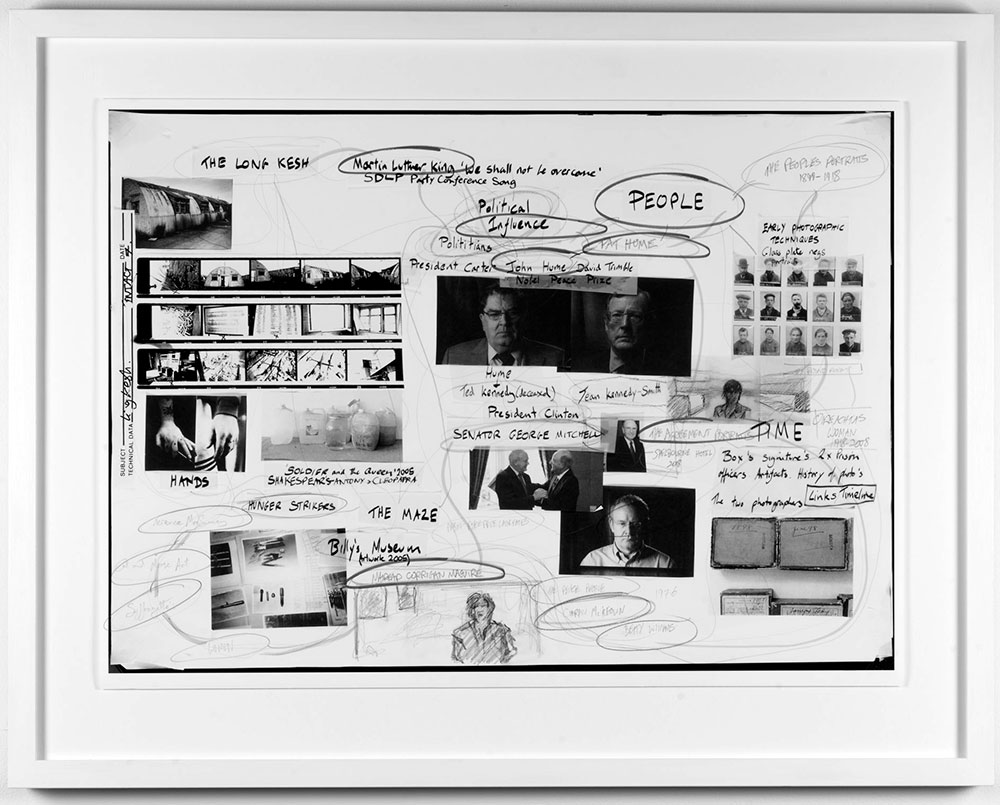
KEEPER Archive and Artworks, 1997 - on-going comprising artworks and gathered material relating to the lived experience of Northern Ireland. Initially artworks were generated from the original Long Kesh compounds (1971) and the cellular HM Prison Maze (1976 – 2000), located outside Belfast, NI. The archive has expanded over twenty-five years and no longer contains elements exclusive to these two sites of incarceration.

The Research Drawing 01, 2020, a colour digital archival pigment print on photographic paper, with graphite and ink (size 59 x 84cm, frame size 65 x 95cm, Edition 1 of 3), maps the KEEPER archive and art project research processes.
Interview for NVTV's art program focuses on her formative years, influences, and Dunsmore's artistic methodologies, including her time as 'artist in residence' at the Maze prison. Artworks discussed and depicted include: Time Trap 1999, Billy's Museum 2004, The Peace People 2017, The Peoples Portraits 1899-1918, 2018 and Nobel Peace Prize Laureate moving image portraits of Mairead Corrigan Maguire, 2017, John Hume, 2004, David Trimble, 2017.
KEEPER artworks are created from found objects, digital video, colour 35mm film, B/W 35mm film photography, 35mm colour slide, audio site recordings and interviews.
Artworks:
Hands 1997, B/W 35mm film photographic prints of prisoners hands inside the HMP Maze prison, size varies. (Currently being reviewed.)
Consuming Politics, orignal VHS recorded NI, TV News and adverts from 1997 and 1998 2-channel video installation. (Currently being re-mastered.)
Time Trap 1999, Northern Visions production by Amanda Dunsmore and prisoners at Long Kesh/H.M.P Maze. +
Bomb 2004, Photographic installation of 20, A4 inkjet colour prints and letter from RUC image of red car in Omagh exploded by the Real IRA on 15 August 1998, NI. (Current-review.)
Billy's Museum 2004/re-mastered 2017, over a period of fifteen years at the height of the conflict, Billy Hull repeatedly disobeyed an order to destroy materials. +
The Maze Hunger Strikers 1981, 2007 audio installation, narrated by then retired Senior HMP Maze Security Officer, Billy Hull. ( Soundcloud +)
The Soldier and The Queen, 2005/re-mastered, 2017, 3-channel / 3-screen, 4:3 video installation, narrated audio, book. Studio Dunsmore vimeo +
The Peace People 2017 - A Vision of the Future Rooted in the Past, Ciaran McKeown, audio installation ( Soundcloud +) - Video portrait of Mairead Corrigan Maguire, 1976 Nobel Peace Prize Laureate and 2021 photographic portrait. +
The Peoples Portraits 1899-1918, 2018 +
AGREEMENT 2004 - 2023, 14 silent video portraits of individuals involved in the Belfast/Good Froday Peace Agreement. +
MEMENTO-AGREEMENT 2023, box edition of 14 print artworks. +
Mo Mowlam 2023, AI/Synthetic media portrait. +

Artworks in development:
HOOCH, clandestine home made alcohol in various containers, made by prisoners housed in the original Long Kesh Compounds, dating from 1976 - 1980.
Locks and Doors, photographic series inside the original Long Kesh Compounds, 1998 - 2000
H8 video from empty ‘in-readiness’ H-block inside functioning Maze prison, overlayed with audio from in use IRA block, 4:3, 14:54 mins, 1998
Long Kesh Panoramas, 14 continuous circular video panorama’s, mapping the vast Long Kesh Compound, filmed 1998 – 2000